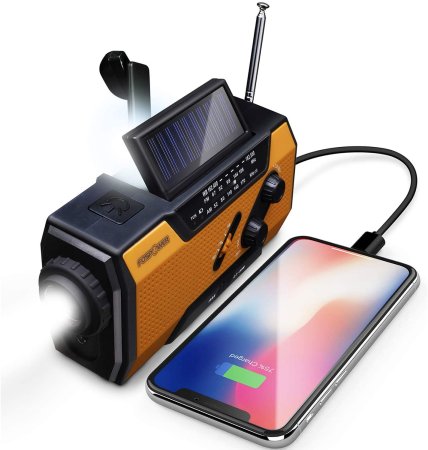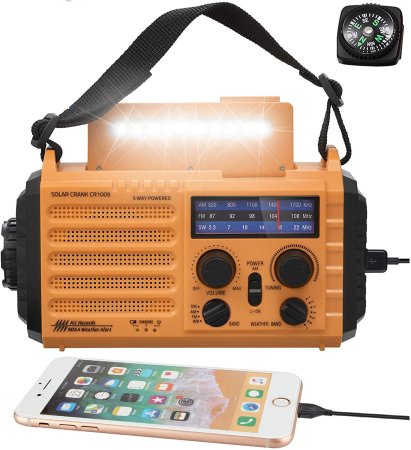

We may earn revenue from the products available on this page and participate in affiliate programs.
A reliable survival radio is a must-have in absolutely any emergency kit. Whether you choose a compact hand-crank radio you can carry with you or a solar-powered larger model to keep in your home or car kit, you have to have a radio you can rely on. When disaster strikes and you find yourself in a survival setting, your radio will go farther than your smartphone. Radios, both regular radios and National Oceanic and Atmospheric Administration (NOAA) weather radios, will relay critical emergency information. Radios are more reliable than smartphones, as you’ll always be able to get a signal; radio waves also travel farther than LTE. When cell phone lines are jammed or down, your radio will be your only connection to updates.
If you’re searching for just the right survival radio, there are plenty of options available. Discover our picks for the best survival radios right here.
FosPower Emergency Portable Radio
Esky Emergency Hand Crank Radio
Kaito 5-Way Solar Emergency Radio
Midland NOAA Emergency Alert Radio
RunningSnail Solar Crank Emergency Radio
Mesqool 5-Way Emergency Radio
Eton American Red Cross Emergency Radio
Holababy Emergency Radio
Aiworth Emergency Survival Radio
Dodocool Emergency Radio
Related: Create a lifeline with the best emergency radios
Why should you trust us
I have nearly a year of experience reviewing products for Brookline Media’s websites, including The Drive and Car Bibles. My past reviews include best ATV bags, best solar chargers for backpacking, and best waterproof tents. I’ve also written historical articles for War History Online, how-to articles for WonderHowTo, and the nonfiction book Fidget! for Adams Media.
Types of survival radios
Technically, any radio can become a survival radio in a pinch. As long as you have a radio that can pick up AM and FM broadcast signals, you’ll be able to tune in to broadcasts. But when you’re focused on survival, having an actual survival radio — one that’s equipped with the tools and radio wavelengths you need in an emergency — is even more important.
Survival radios share many of the same features and capabilities. But there are two different types of these radios: AM/FM and weather alert. Each specific type offers its own benefits and disadvantages. Read on to discover which is the best fit for your emergency kit.
AM/FM survival radios
AM/FM survival radios, which are also often called simply emergency radios, are able to pick up AM and FM radio frequencies. They’ll keep you informed on the latest information when you’re in a developing situation, allowing you to access both local radio stations and those that are farther away. This kind of emergency radio is typically used when the power goes out — so, these radios don’t always have a wealth of extra features.
Your average AM/FM survival radio features multiple power options, like a hand crank, solar charging, and traditional wall outlet or battery power. This ensures you’ll be able to use your radio even when your access to electricity is nonexistent. These radios can also include survival extras, like a built-in flashlight, an emergency alert sound, and extra battery power.
Weather alert survival radios
A weather alert survival radio is a more specialized kind of emergency device. These radios are able to broadcast alerts from NOAA, giving you critical information about weather in your area. You can even fine-tune your alerts if you choose a weather alert radio that includes Specific Area Message Encoding (SAME) capability. Many weather alert models also allow you to tune in to local radio stations for updates and alerts beyond the weather. This versatility can be especially handy in a survival situation.
Additionally, these radios often include all of the same features of AM/FM survival radios. You’ll find options with flashlights, emergency lights or alerts, backup battery power, and more.
What to consider when buying a survival radio
As you try to decide which survival radio is the right pick for your emergency supplies, it’s important to consider both how the radio works and how much functionality it offers.
Many survival radios offer multiple operation methods. It’s common for a single radio to run on batteries as well as a hand crank and solar power. This gives you more versatility in survival situations; if one method won’t power your radio, you have other options you can try. Look for a radio that’ll work even when you have access to nothing at all — one that can use hand cranking and solar charging to regain power. Batteries, electricity, and even USB charging can all fail in an emergency.
You’ll also want to assess what kinds of other helpful functions a survival radio offers. The more you can do with your radio, the more you’ll streamline your emergency gear. Some radios come equipped with multiple flashlights, emergency sirens and signals, and even backup power sources so you can recharge items like your flashlights, smartphone, and more. Other radios are simpler and work solely as radios.
Do you need a survival radio?
Absolutely everyone needs a survival radio packed in their emergency kit or carried with them each day. A survival radio is a critical device when the unexpected happens — it can rapidly become your only connection to the latest news, key information, and status of your local area. It’s more reliable than your cell phone, and it’s what you’ll depend on if power lines, cell service, and other important services are rendered unavailable in an emergency.
Connectivity and information aren’t the only advantages of carrying a survival radio. In addition to offering you updates about local weather and emergency situations, these compact devices can also give you other survival perks. These include:
- A renewable power source that offers USB charging for other electronics and high-power items, including flashlights, cell phones, tablets, and more.
- Multiple modes of charging or resupplying power, like solar charging, hand cranking, and more.
- The freedom to not be reliant on electricity or cell service when these are unavailable or down.
- Multiple survival tools in one, like flashlights, SOS lights or alerts, and backup battery power.
- The ability to carry information wherever you go in a lightweight, compact device.
Pricing ranges for survival radios
- Under $20: If you’re looking for a basic survival radio with a compact size and simple features, you can find plenty of options for less than $20. These radios can come in AM/FM or weather alert formats, and most offer extras like flashlights and backup power source capability.
- $20 to $60: Spend a bit more, and you can get even more out of a survival radio. For $20 to $60, you’ll find options that are both AM/FM and NOAA weather alert models. These radios tend to be packed with extra features, too, giving you three or more power options plus extras like SOS lighting, flashlights, and great durability.
How we chose our top picks
To choose our best survival radio picks, we examined the products available on Amazon and focused on those with the highest ratings and the most customer reviews. We assessed the functionality and features of each radio and took customers’ comments and experiences with them into account to choose the best of the bunch.









